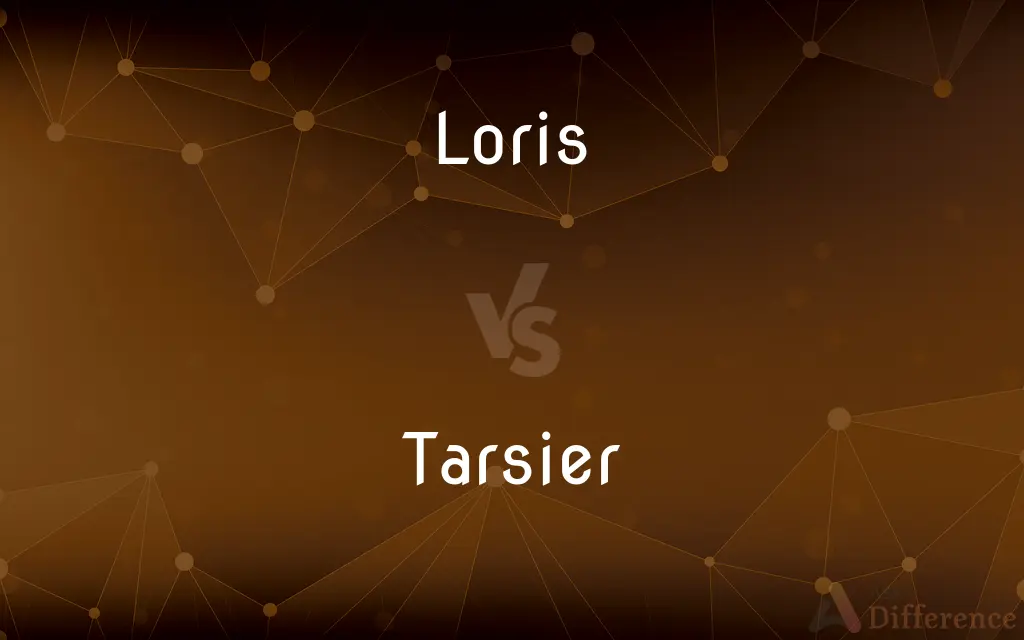Loris vs. Tarsier — What's the Difference?
By Maham Liaqat & Fiza Rafique — Updated on March 26, 2024
Lorises are slow-moving primates known for their nocturnal lifestyle, while tarsiers are small, agile primates with large eyes and unique jumping abilities.

Difference Between Loris and Tarsier
Table of Contents
ADVERTISEMENT
Key Differences
Lorises belong to the family Lorisidae, consisting of small to medium-sized primates found in India, Sri Lanka, Southeast Asia, and parts of Africa. They are characterized by their slow, deliberate movements and strong grasp, thanks to their opposable thumbs. Tarsiers, on the other hand, are members of the family Tarsiidae, small primates that inhabit the islands of Southeast Asia. They are known for their incredible jumping ability, facilitated by their powerful hind legs and elongated tarsal bones.
Lorises are nocturnal, with large eyes adapted for night vision, and have a diet consisting mainly of fruits, gums, and occasionally insects. Their slow movement is a strategy to avoid predators and to hunt prey quietly. Tarsiers have massive eyes relative to their body size, which are fixed in their skulls; this adaptation aids their nocturnal lifestyle. Unlike lorises, tarsiers are exclusively insectivorous, catching prey by leaping at it from a distance.
While both lorises and tarsiers are adapted to a nocturnal lifestyle, featuring large eyes for night vision, their modes of locomotion and dietary habits significantly differ. Lorises move slowly and cautiously, using their grip to navigate through the trees, whereas tarsiers are capable of making long, precise jumps to catch their prey or move between tree branches.
Another key difference lies in their social behavior and reproduction. Lorises tend to be solitary or live in small family groups, with a slow reproductive rate. Tarsiers, while also primarily solitary, have unique vocal communications and territorial behaviors not seen in lorises. Their reproductive rate varies, but like lorises, they typically have a low birth rate, with extensive parental care for the young.
Conservation status is a concern for both lorises and tarsiers, with habitat destruction and the pet trade posing significant threats. Efforts are ongoing to protect their natural habitats and to educate the public about the ecological roles of these unique primates.
ADVERTISEMENT
Comparison Chart
Family
Lorisidae
Tarsiidae
Habitat
India, Sri Lanka, Southeast Asia, parts of Africa
Islands of Southeast Asia
Locomotion
Slow and deliberate, arboreal
Agile jumpers, capable of long leaps
Diet
Fruits, gums, insects
Exclusively insectivorous
Eyes
Large, adapted for nocturnal vision
Extremely large relative to body, fixed in skull
Social Behavior
Solitary or small family groups
Primarily solitary, with unique vocal communications
Conservation
Threatened by habitat destruction and the pet trade
Similarly threatened, with specific concerns per species
Notable Adaptations
Strong grip and slow movement to avoid predators
Powerful hind legs for jumping and elongated tarsal bones
Compare with Definitions
Loris
Slow movement.
A loris moves slowly to sneak up on insects or avoid predators.
Tarsier
Exceptional jumpers.
A tarsier can leap over 40 times its body length between trees.
Loris
Conservation concerns.
Lorises face threats from habitat destruction and illegal pet trade.
Tarsier
Insectivorous diet.
Tarsiers exclusively eat insects, catching them mid-air with precise jumps.
Loris
Nocturnal lifestyle.
Lorises use their large eyes to navigate the dark forests.
Tarsier
Large eyes.
Tarsiers have massive eyes that help them spot prey at night.
Loris
Opposable thumbs.
Lorises have a strong grip, allowing them to hold onto branches securely.
Tarsier
Sensitive to habitat changes.
Tarsiers require dense forests for survival, making them vulnerable to deforestation.
Loris
Dietary variety.
Lorises eat fruits and gums, supplementing their diet with insects.
Tarsier
Solitary with unique vocalizations.
Tarsiers communicate with distinct sounds to establish territories.
Loris
Loris is the common name for the strepsirrhine primates of the subfamily Lorinae (sometimes spelled Lorisinae) in the family Lorisidae. Loris is one genus in this subfamily and includes the slender lorises, while Nycticebus is the genus containing the slow lorises.
Tarsier
Tarsiers are haplorrhine primates of the family Tarsiidae, which is itself the lone extant family within the infraorder Tarsiiformes. Although the group was once more widespread, all of its species living today are found in Maritime Southeast Asia, specifically the Philippines, Malaysia, Indonesia, and Brunei.They are found primarily in forested habitats, especially forests that have liana, since the vine gives tarsiers vertical support when climbing trees.
Loris
Any of various primates of the family Lorisidae of sub-Saharan Africa and tropical Asia, having a very short or absent tail, and including the pottos.
Tarsier
Any of several small insectivorous primates of the genus Tarsius of Brunei, Indonesia, Malaysia, and the Philippines, being nocturnal and arboreal and having extremely large round eyes, a long tail, and long digits with nails except for the second and third toes, which have claws.
Loris
Any of several small, slow-moving nocturnal members of this family in the genera Loris and Nycticebus of tropical Asia, having dense woolly fur and large eyes.
Tarsier
An insectivorous primate of the family Tarsiidae, having very large eyes and long feet, native mainly to several islands of Southeast Asia.
Loris
Any of several small, slow-moving primates, of the family Lorisidae, found in India and southeast Asia.
Tarsier
See Tarsius.
Loris
Any one of several species of small lemurs of the genus Stenops. They have long, slender limbs and large eyes, and are arboreal in their habits. The slender loris (Stenops gracilis), of Ceylon, in one of the best known species.
Tarsier
Nocturnal arboreal primate of Indonesia and the Philippines having huge eyes and digits ending in pads to facilitate climbing; the only primate that spurns all plant material as food living entirely on insects and small vertebrates
Common Curiosities
Are tarsiers capable of rotating their heads?
Yes, tarsiers can rotate their heads almost 180 degrees, compensating for their fixed eyes.
What are the main threats to lorises and tarsiers?
Both face threats from habitat destruction and the illegal pet trade, although specific threats vary by species and location.
Why are lorises and tarsiers nocturnal?
Their nocturnal nature allows them to avoid predators and exploit food resources with less competition.
How do lorises and tarsiers differ in their social behavior?
Lorises are more solitary or live in small family groups, while tarsiers are solitary but use vocal communications for social interactions.
What distinguishes lorises from tarsiers?
Lorises are known for their slow movement and varied diet, while tarsiers are recognized for their jumping abilities and exclusive insectivorous diet.
Can lorises and tarsiers be kept as pets?
Although they are sometimes kept as pets, it is neither recommended nor ethical due to their complex care requirements and the stress it causes them.
What efforts are being made to conserve lorises and tarsiers?
Conservation efforts include habitat protection, research, and education to raise awareness about their ecological importance and threats.
Do lorises have any unique defensive mechanisms?
Some loris species produce a toxin, which they can mix with saliva to deliver a painful bite.
How do tarsiers communicate?
Tarsiers use a variety of vocalizations to communicate, especially for territory marking and mating calls.
What role do lorises and tarsiers play in their ecosystems?
As predators of insects and, for lorises, consumers of fruit, they play key roles in controlling insect populations and in seed dispersal, contributing to forest health.
Share Your Discovery

Previous Comparison
Goods vs. Merchandise
Next Comparison
Got vs. WasAuthor Spotlight
Written by
Maham LiaqatCo-written by
Fiza RafiqueFiza Rafique is a skilled content writer at AskDifference.com, where she meticulously refines and enhances written pieces. Drawing from her vast editorial expertise, Fiza ensures clarity, accuracy, and precision in every article. Passionate about language, she continually seeks to elevate the quality of content for readers worldwide.
















































